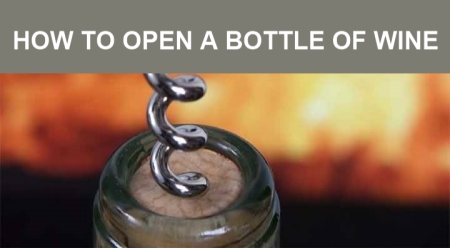Vivere il vino consigli |
|
|
Come aprire una bottiglia di vino
|
|

|
|
|
Aprire una bottiglia di vino è un compito piuttosto semplice, ma bisogna evitare di commettere alcuni errori comuni da non rovinare il tappo ed il vino in particolare. Prendi un cavatappi professionale.
Il cavatappi tradizionale sono molto utili, e sono grandi per l'apertura di bottiglie di vino che potremmo sommariamente definire "quotidiano", ma per aprire bottiglie di vino un po 'più importanti sono meno adatti, per la facilità di rottura del sughero. Un cavatappi da sommelier a doppia leva fa per noi.
Con il coltello seghettato, rimuovere la porzione della capsula che copre il tappo di sughero. Tagliare appena sotto la cresta, sul collo della bottiglia vicino alla cima. Questo perché, se ci fossero residui di polvere, non cadrebbe nel bicchiere. Pulire con cura ,con un panno pulito, il collo della bottiglia da ogni residuo.
Posizionare la punta del cavatappi, la spirale, nel centro del tappo e iniziare a girare, senza spingere, ma con un movimento costante. Attenzione: è il cavatappi che ruota non la bottiglia, altrimenti si potrebbe smuovere il fondo. Stringere la vite senza fine quasi alla fine: è importante non forare il tappo sul fondo per non trovare trucioli di sughero nel vino. Se si dispone di un cavatappi a due leve, come raccomandato, posto il primo dente (quello vicino alla giunzione) tirare fino al collo della bottiglia, e con movimento costante, senza strappi.
Posizionare ora il secondo dente sul collo della bottiglia e, ancora, leva per rimuovere quasi il tappo. Durante questa operazione, prestare particolare attenzione a non piegare il sughero per non romperlo. Con il sughero ormai quasi completamente uscito, inclinare leggermente il cavatappi a tirare fuori il sughero intero.
Guarda il tappo: verifica che non è troppo secco, o non troppo bagnato: deve essere umido per due o tre millimetri. Se non lo e' assaggiare il vino.
Odorate il tappo: se l'odore primario è quello del vino è possibile versare direttamente, ma se prevale l'odore di sughero, è meglio degustare il vino per evitare spiacevoli sorprese.
Versare il vino lentamente dall'alto, per ossigenarlo. E 'una buona idea aprirei vini importanti diverse ore prima del pasto per consentire una buona ossigenazione. I vini rossi di gran corpo e struttura, di vecchie annate dovrebbero essere decantati. Se si serve un vino di particolare importanza, è una buona idea avvinare i bicchieri con un po 'di vino per eliminare eventuali residui di detersivo. Attenzione: i vini rossi maturi hanno spesso un piccolo deposito.
L'operazione di travaso deve impedire il pericolo di trovare quei residui nel bicchiere, ma se non è possibile travasare il vino, cercare di evitare di scuotere la bottiglia e di non versare l'intero contenuto, ma lasciano sempre un po 'di vino in bottiglia e versarla con attenzione.
Il cavatappi tradizionale sono molto utili, e sono grandi per l'apertura di bottiglie di vino che potremmo sommariamente definire "quotidiano", ma per aprire bottiglie di vino un po 'più importanti sono meno adatti, per la facilità di rottura del sughero. Un cavatappi da sommelier a doppia leva fa per noi.
Con il coltello seghettato, rimuovere la porzione della capsula che copre il tappo di sughero. Tagliare appena sotto la cresta, sul collo della bottiglia vicino alla cima. Questo perché, se ci fossero residui di polvere, non cadrebbe nel bicchiere. Pulire con cura ,con un panno pulito, il collo della bottiglia da ogni residuo.
Posizionare la punta del cavatappi, la spirale, nel centro del tappo e iniziare a girare, senza spingere, ma con un movimento costante. Attenzione: è il cavatappi che ruota non la bottiglia, altrimenti si potrebbe smuovere il fondo. Stringere la vite senza fine quasi alla fine: è importante non forare il tappo sul fondo per non trovare trucioli di sughero nel vino. Se si dispone di un cavatappi a due leve, come raccomandato, posto il primo dente (quello vicino alla giunzione) tirare fino al collo della bottiglia, e con movimento costante, senza strappi.
Posizionare ora il secondo dente sul collo della bottiglia e, ancora, leva per rimuovere quasi il tappo. Durante questa operazione, prestare particolare attenzione a non piegare il sughero per non romperlo. Con il sughero ormai quasi completamente uscito, inclinare leggermente il cavatappi a tirare fuori il sughero intero.
Guarda il tappo: verifica che non è troppo secco, o non troppo bagnato: deve essere umido per due o tre millimetri. Se non lo e' assaggiare il vino.
Odorate il tappo: se l'odore primario è quello del vino è possibile versare direttamente, ma se prevale l'odore di sughero, è meglio degustare il vino per evitare spiacevoli sorprese.
Versare il vino lentamente dall'alto, per ossigenarlo. E 'una buona idea aprirei vini importanti diverse ore prima del pasto per consentire una buona ossigenazione. I vini rossi di gran corpo e struttura, di vecchie annate dovrebbero essere decantati. Se si serve un vino di particolare importanza, è una buona idea avvinare i bicchieri con un po 'di vino per eliminare eventuali residui di detersivo. Attenzione: i vini rossi maturi hanno spesso un piccolo deposito.
L'operazione di travaso deve impedire il pericolo di trovare quei residui nel bicchiere, ma se non è possibile travasare il vino, cercare di evitare di scuotere la bottiglia e di non versare l'intero contenuto, ma lasciano sempre un po 'di vino in bottiglia e versarla con attenzione.

